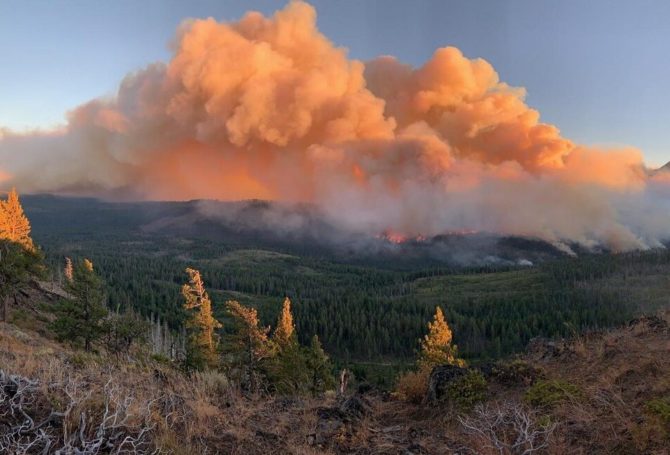
Wildfire smoke toxicity is unhealthier than previously thought, according to research by the Scripps Institution of Oceanography in San Diego that was published in Nature Communications last week.
“Air pollution has been decreasing in some regions of the US,” says Rosana Aguilera, one of the study’s co-authors. “This is not the case in wildfire-prone areas.”
Wildfire smoke contains small particles known as PM2.5 that can lodge deeply in human lungs and absorb into the bloodstream. Toxicologists know PM2.5 particles from burning organic material are more toxic to humans than car or industrial emissions. The Scripps research quantifies just how much more toxic.
Scripps researchers analyzed air pollution data in Southern California over a 14-year period, which showed incidences of wildfire smoke led to 10 percent more hospital admissions for respiratory conditions than other sources of PM2.5 particulate pollution.
Tom Corringham, co-author of the Scripps research findings, told OPB, “We don’t have any reason to believe that there would be significant differences [In the Northwest] based on vegetation type. I think we would expect these results to transfer and to be fairly uniform across the West.”
OHSU environmental toxicologist Caren Weinhouse, who was not part of the Scripps research team, said it was known wildfires create more toxic particulate matter than other sources, but the toxicity of wildfire smoke had not been “quantified in terms of real-world health impacts over a long period of time.”
The findings carry special meaning for wildland firefighters whose workplace is surrounded in smoke and who inhale a cocktail of nasty substances, which increase their risk of short and long-term respiratory and cardiovascular disease. Wildfire smoke unleashes formaldehyde, sulfur dioxide, carbon monoxide and benzene as well particulate matter, which can irritate eyes and skin, inflame lungs and cause lasting damage.
We’re pretty aware of the physical costs of wildfire, in terms of firefighting costs and damage to property. But the health impacts due to wildfire smoke are on the same order of magnitude, or possibly even greater, than the direct physical cost.
Corringham says the federal Environmental Protection Agency currently regulates all sources of PM2.5 pollution the same. His team suggests developing a more sophisticated scale that takes into account toxicity levels. Under such a system, Corringham predicts more frequent health care warnings would be issued when wildfire smoke is present. He also urges more preventive measures to protect vulnerable populations close to or downwind from wildfires.
Scientists indicate serious wildfires may become more common as a result of rising temperatures and extended draught conditions. Forest managers also want to ignite more prescribed wildland fires to reduce the amount of vegetation that fuels wildfires. Unlike other forms of similar pollution, wildfire smoke is uncontrollable, as an estimated one in seven West Coast residents experienced last year.
Oregon lawmakers are dealing with the physical and economic damage caused by last year’s devastating wildfires, but don’t have proposals to address short-term and long-term health effects of wildfire smoke exposure on residents and wildland firefighters.
“We’re pretty aware of the physical costs of wildfire, in terms of firefighting costs and damage to property,” Corringham says. “But there’s been a lot of work that has shown that the health impacts due to wildfire smoke are on the same order of magnitude, or possibly even greater, than the direct physical cost.”




